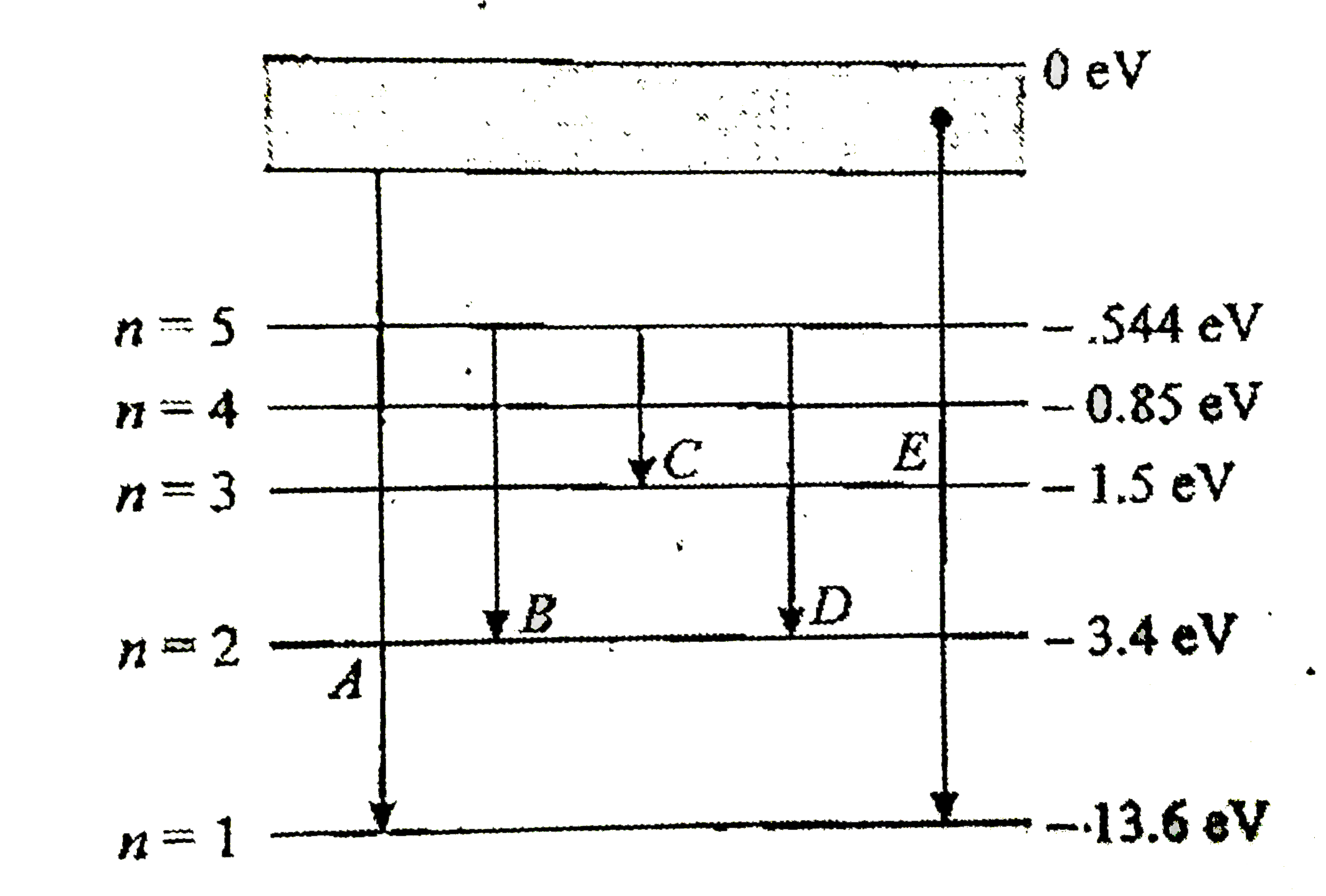Complete Solutions to Exercise 2 (MISCELLANEOUS PROBLEMS) of chapter ATOMS, MOLECULES AND NUCLEI of Class 12 book with complete answers and questions
| Class 12 | PHYSICS |
| Chapter | ATOMS, MOLECULES AND NUCLEI |
| MHTCET PREP GUIDE | Exercise 2 (MISCELLANEOUS PROBLEMS) |
| Number Of Questions | 26 |
| Academic Year | 2023-24 |
To explain theory of hydrogen atom, Bohr considered
View SolutionThe ratio of kinetic energy to the total energy of an electron in a Bohr orbit of the hydrogen atom, is
View SolutionIn a hypothetical Bohr hydrogen atom, the mass of the electron is double then
View SolutionAn electron jumps from the `4th` orbit to the `2nd` orbit of hydrogen atom. Given the Rydberg's constant `R = 10^(5) cm^(-1)`. The frequency in `Hz` of the emitted radiation will be
View SolutionIn the following figure the energy levels of hydroge atom have been shown along with some transitions marked A, B,C,D and E.The transitionsy A,B and C respectively represent:

View SolutionAn hydrogen atom moves with a velocity u and makes a head on inelastic collision with another stationary H-atom. Both atoms are in ground state before collision. The minimum value of u if one of them is to be given a minimum excitation energy is
View SolutionA hydrogen like ion having wavelength difference between first Balmer and Lyman series equal 593 Å has Z equal to
View SolutionIn the Bohr's model of hydrogen-like atom the force between the nucleus and the electron is modified as `F=(e^(2))/(4piepsi_(0))((1)/(r^(2))+(beta)/(r^(3)))`, where `beta` is a constant. For this atom, the radius of the nth orbit in terms of the bohr radius `(a_(0)=(epsi_(0)h^(2))/(mpie^(2)))` is
View SolutionIn rutherford's experiment, the mumber of alpha-particles scattered through an angle of `90^(@)` is 28 per minute. Then,the number of particles scattered through an angle of `60^(@)`per minute by the same nucleus is
View SolutionA small particle of mass m move in such a way the potential energy `(U = (1)/(2) m^(2) omega^(2) r^(2))` when a is a constant and r is the distance of the particle from the origin Assuming Bohr's model of quantization of angular momentum and circular orbits , show that radius of the nth allowed orbit is proportional to in
View SolutionIn the Bohr model an electron moves in a circular orbit around the proton. Considering the orbiting electron to be a circular current loop, the magnetic moment of the hydrogen atom, when the electron is in nth excited state, is :
View SolutionIn a hydrogen like atom electron make transition from an energy level with quantum number `n` to another with quantum number `(n - 1)` if `n gtgt1` , the frequency of radiation emitted is proportional to :
View SolutionIf the atom`""_100Fm^(257)` follows the Bohr model the radius of `""_100Fm^(257)` is `n` time the Bohr radius , then find `n` .
View SolutionGiven a sample of radius -226 having half-life of 4 days. Find, the probability, a nucleus disintegrates after 2 half lifes.
View SolutionHydrogen atom is exited from ground state to another state with principal quantum number equal to `4` Then the number of spectral line in the emission spectra will be
View SolutionA diatomic molecule is made of two masses `m_(1) and m_(2)` which are separated by a distance `r` . If we calculate its rotational energy by applying Bohr's rule of angular momentum quantization it energy will be ( n is an integer )
View SolutionSuppose an electron is attracted toward the origin by a force`(k)/(r )` where `k` is a constant and `r` is the distance of the electron from the origin .By applying Bohr model to this system the radius of the `n^(th)` orbital of the electron is found to be `r_(n)` and the kinetic energy of the electron to be `T_(n)` , Then which of the following is true ?
View SolutionThe largest wavelength in the ultraviolet region of the hydrogen spectrum is `122` nm. The smallest wavelength in the infrared region of the hydrogen spectrum (to the nearest integer) is
View SolutionThe filament current in the electron gun of a coolidge tube is increased while the potential difference used to accelerate the electrons is decreased. As a result, in the emitted radiation
View SolutionThe binding energy of the innermost electron in tungsten is `40 keV`. To produce characteristic `X` - rays using a tungsten target in an `X` - rays tube the potential difference `V` between the cathode and the anti - cathode should be
View SolutionHydrogen `(""_(1)H^(1))`, Deuterum `(""_(1)H^(2))`, singly ionised Hellium `(""_(2)He^(4))^(+)` and doubly ionised lithium `(""_(3)Li^(6))^(++)` all have one electron around the nucleus. Consider an electron tranition from `n=2` to `n=1`. If the wave lengths of emitted radiation are `lambda_(1),lambda_(2),lambda_(3)` and `lambda_(4)` respectively then approximately which one of the follwing is correct ?
View SolutionElectrons with energy `80 keV` are incident on the tungsten target of an X - rays tube , k- shell electrons of tungsten have `72.5 keV` energy X- rays emitted by the tube contain only
View SolutionDuring X-ray production from coolidge tube if the current increased, then
View SolutionA charged oil drop falls with terminal velocity `v_(0)` in the absence of electric field. An electric field E keeps it stationary. The drop acquires charge 3q, it starts moving upwards with velocity `v_(0)`. The initial charge on the drop is
View SolutionTwo identical photocathode receive light of frequencies `f_(1)` and `f_(2)`. If the maximum velocities of the photoelectrons (of mass m) coming out are respectively `v_(1)` and `v_(2)` then:
View SolutionAn oil drop carrying a charge q has a mass m kg. it is falling freely in air with terminal speed v. the electric field required to make, the drop move upwards with the same speed is
View Solution
Exercise 2 (MISCELLANEOUS PROBLEMS) questions and complete solutions for chapter ATOMS, MOLECULES AND NUCLEI of MHTCET PREVIOUS YEAR PAPERS AND PRACTICE PAPERS of Class 12